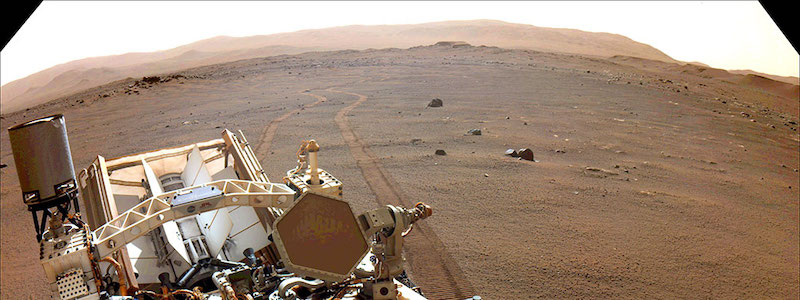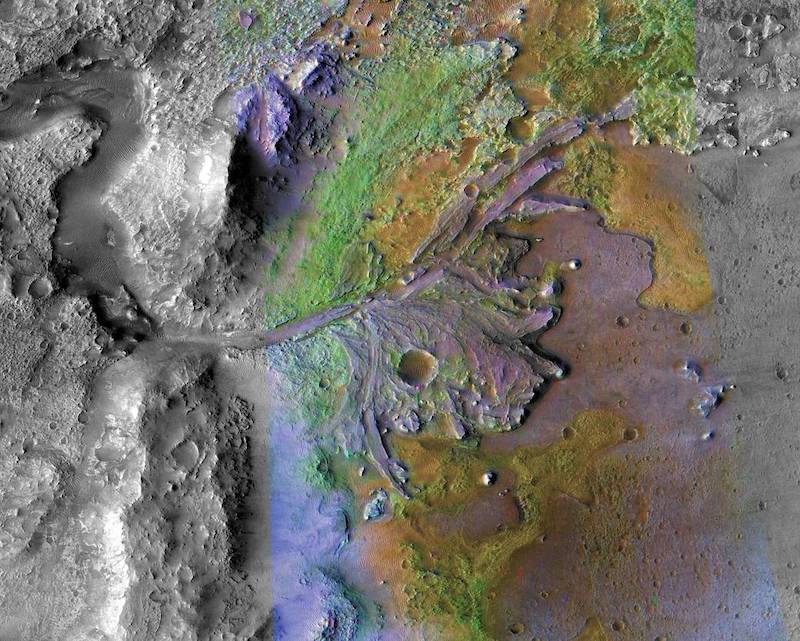
Would you like to see an ancient Martian river delta up close? Soon you’ll be able to. NASA said, in March 2022, that its Perseverance rover has completed its current science campaign in Jezero Crater. The rover is now making a beeline for the primary goal of its mission: the river delta within the crater. An ancient Mars lake existed here, billions of years ago. So the sediments in the delta could contain traces of fossilized bacterial life, if such life ever existed on Mars.
The Mars rovers don’t travel very fast. They creep across Mars’ surface. Perseverance’s top speed lies at about 0.07 mph (0.12 kph). It began its 3-mile (5-km) journey to the delta on March 14, 2022.
But, given that the rovers move slowly, Perseverance isn’t wasting any time. The rover is traveling to the delta in a series of record-breaking “sprints.” The goal is to cover more distance in one month than any other previous rover.
How is this possible? After all, NASA said, there are sandpits, craters, and fields of sharp rocks on the path ahead. But Perseverance’s self-driving technology is far superior to that of any other rover. And Perseverance is using self-driving capabilities thanks to artificial intelligence (AI) to make the trip.
Perseverance rover and artificial intelligence
AI helps the rover to navigate on its own without additional assistance from human controllers on Earth. And Perseverance’s AutoNav system is the most advanced of any rover sent to Mars so far. Mark Maimone of NASA’s Jet Propulsion Laboratory explained:
Self-driving processes that took minutes on a rover like Opportunity happen in less than a second on Perseverance. Because autonomous driving is now faster, we can cover more ground than if humans programmed every drive.
AutoNav and AI help the rover to avoid large rocks and dangerous slopes on its own. Humans still need to plan the basic routes, however, using images taken from orbit. Then, they mark obstacles such as potential sand traps for Perseverance to avoid. They draw “keep out” and “keep in” zones that help it navigate.
A new way of roving on Mars
So, just how does the AutoNav system work? Perseverance has no less than 14 human mobility planning experts back on Earth. They send computer commands to the rover using NASA’s Deep Space Network. After the rover has, hopefully, completed the commanded drive, it sends that data back to Earth. It’s a complex task. One recent drive stretched out to 1,673 feet (510 meters), and required thousands of individual commands.
Other rovers have also used AutoNav to an extent, but the system for Perseverance is the most advanced yet. Basically, the rover is “thinking while driving.” The rover uses the images it takes to navigate and avoid unwelcome obstacles, without help from the rover team back on Earth. This is possible thanks to upgraded hardware on the rover. The cameras can take photos faster than before, which allows the rover to navigate in real-time. In fact, Perseverance has an additional onboard computer that is dedicated to only processing photos. The computer uses a super-efficient microchip called a field-programmable gate array.
Maimone said:
On past rovers, autonomy meant slowing down because data had to be processed on a single computer. This extra computer is insanely fast compared to what we had in the past, and having it dedicated for driving means you don’t have to share computing resources with over 100 other tasks.

A safety bubble for Perseverance rover
Perseverance also has its own “safety bubble” as established by AutoNav. This bubble is a small “virtual box” centered on each of the rover’s six wheels. On the older (but still working) Curiosity rover, the bubble is much larger at 16 feet (5 m) wide. For example, if there is a gap between two rocks that is too close to that margin, say 15 feet (4.6 m), the rover will automatically go around the rocks instead of trying to pass between them. But for Perseverance, the smaller bubble means the rover can navigate through such terrain more easily. Maimone said:
When we first looked at Jezero Crater as a landing site, we were concerned about the dense fields of rocks we saw scattered across the crater floor. Now we’re able to skirt or even straddle rocks that we couldn’t have approached before.
A big benefit of this is that Perseverance can move more quickly than previous rovers, and reach its targets in a shorter time.

Searching for life in an ancient delta
Why are the mission scientists so eager to get to the delta? They want to be able to take samples of the rocks and sediments, which could contain evidence of past microbial life. On Earth, deltas are excellent locations to find preserved microscopic life. The Martian delta is just like earthly ones, where a river once emptied into the lake that used to exist in Jezero Crater billions of years go. Perseverance project scientist Ken Farley of Caltech stated:
The delta is so important that we’ve actually decided to minimize science activities and focus on driving to get there more quickly. We’ll be taking lots of images of the delta during that drive. The closer we get, the more impressive those images will be.
The new images will be exciting, but they will also help scientists pick out rocks that the rover can study in more detail. Perseverance will collect samples, and as with samples from previous locations, will store them in tubes for eventual return to Earth in the Mars Sample Return Mission. The rover also conducts its own analysis of the samples with its onboard laboratory. Scientists will be able to analyze the samples in much greater detail, however, in labs on Earth.


The mission so far
Perseverance successfully landed on Mars on February 18, 2021. Since then, it has been busy exploring the ancient lake bed in Jezero Crater. It has already found abundant organics preserved in rocks, although not proof of life itself yet. Perseverance confirmed that Jezero Crater really was a lake a few billion years ago. Most recently, it has been studying rocks with unusual purple coatings on them.
It’s companion, the Mars Helicopter, just completed its 23rd flight! The drone-like quadcopter is the first aerial vehicle to ever be flown in the Martian atmosphere.
Bottom line: NASA’s Perseverance rover is heading to an ancient river delta on Mars in record time, thanks to an advanced navigation system using artificial intelligence. The rover will search for evidence of ancient microbial life in the sediments of the delta.











